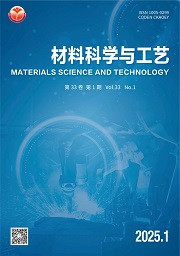| 引用本文: | 黄淼,冯道臣,刘一飞,郑文健,闫德俊,赖少波,杨建国.电子束表面重熔高熵合金疲劳裂纹扩展行为研究[J].材料科学与工艺,2024,32(6):1-9.DOI:10.11951/j.issn.1005-0299.20230110. |
| HUANG Miao,FENG Daochen,LIU Yifei,ZHENG Wenjian,YAN Dejun,LAI Shaobo,YANG Jianguo.Research on fatigue crack growth behavior of electron beam surface remelted high entropy alloys[J].Materials Science and Technology,2024,32(6):1-9.DOI:10.11951/j.issn.1005-0299.20230110. |
|
| |
|
|
| 本文已被:浏览 557次 下载 147次 |

码上扫一扫! |
|
|
| 电子束表面重熔高熵合金疲劳裂纹扩展行为研究 |
|
黄淼1,冯道臣1,刘一飞3,郑文健1,2,3,闫德俊1,3,赖少波3,杨建国1,2
|
|
(1.浙江工业大学 机械工程学院,杭州 310023;2.浙江工业大学 过程装备及其再制造教育部工程研究中心,杭州 310023; 3.中船黄埔文冲船舶有限公司 广东省舰船先进焊接技术企业重点实验室,广州 510715)
|
|
| 摘要: |
| 为改善铸态双相高熵合金AlCoCrFeNi2.1的疲劳性能,本文采用电子束表面重熔方法对铸态合金进行双面重熔,利用扫描电子显微镜、元素能谱分析、硬度测试表征了电子束重熔对合金的微观组织形貌、元素分布、显微硬度的影响,采用疲劳裂纹扩展速率测试以及有限元分析等方法,研究了电子束重熔处理后高熵合金的疲劳裂纹扩展行为及机制。研究表明:电子束表面重熔能够显著细化双相尺寸,改善合金元素的偏析情况,提升表面硬度;由重熔区与热影响区组成的异质结构的疲劳裂纹扩展速率大幅度下降,且其疲劳裂纹扩展的前沿呈现“M形”。重熔区相尺寸的细化、异质结构内部分布的残余压应力以及异质结构的力学性能差异是抑制其疲劳裂纹扩展的主要原因。 |
| 关键词: 双相高熵合金 疲劳裂纹扩展 电子束重熔 异质结构 有限元分析 |
| DOI:10.11951/j.issn.1005-0299.20230110 |
| 分类号:TG111.8 |
| 文献标识码:A |
| 基金项目:国家自然科学基金资助项目(51975530). |
|
| Research on fatigue crack growth behavior of electron beam surface remelted high entropy alloys |
|
HUANG Miao1,FENG Daochen1,LIU Yifei3,ZHENG Wenjian1,2,3,YAN Dejun1,3,LAI Shaobo3,YANG Jianguo1,2
|
|
(1.College of Mechanical and Engineering, Zhejiang University of Technology, Hangzhou 310023, China; 2.Engineering Research Center of Process Equipment and Remanufacturing, Ministry of Education, Zhejiang University of Technology, Hangzhou 310023, China; 3.Guangdong Provincial Key Laboratory of Advanced Welding Technology for Ships, CSSC Huangpu Wenchong Shipbuilding Company Limited, Guangzhou 510715, China)
|
| Abstract: |
| In order to improve the fatigue property of the as-cast AlCoCrFeNi2.1 dual phase high entropy alloy, this as cast alloy was remelted on both sides by electron beam surface remelting. The effects of electron beam remelting on the microstructure, element distribution and microhardness of the alloy were characterized by scanning electron microscope (SEM), energy dispersive spectrometer (EDS) and hardness testing. The fatigue crack growth behavior and mechanism of high entropy alloy after electron beam remelting were studied by means of fatigue crack growth rate (FCGR) test and finite element analysis (FEM). Results show that the electron beam surface remelting can significantly refine the dual phase size, improve the segregation of alloy elements and enhance the surface hardness. The FCGR of this heterostructure composed of remelting zone and heat affected zone decreases significantly, and the front of fatigue crack growth presents an "M" shape. The refinement of the phase size in remelting zone, the residual compressive stress distributed in the heterostructure and the difference in the mechanical properties of the heterostructure are the main reasons for inhibiting the fatigue crack growth. |
| Key words: dual phase high entropy alloy fatigue crack growth EBM heterostructure FEM |
|
|
|
|






